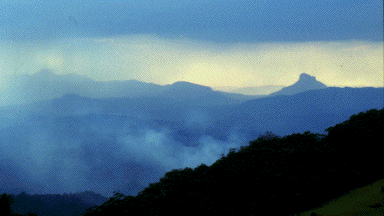 Storms, such as this one that occurred on the third day of our visit, are
a common occurrence and important environmental feature of the subtropical
rainforest at Lamington.
Storms, such as this one that occurred on the third day of our visit, are
a common occurrence and important environmental feature of the subtropical
rainforest at Lamington.
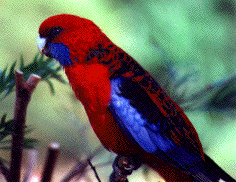
 Storms, such as this one that occurred on the third day of our visit, are
a common occurrence and important environmental feature of the subtropical
rainforest at Lamington.
Storms, such as this one that occurred on the third day of our visit, are
a common occurrence and important environmental feature of the subtropical
rainforest at Lamington.
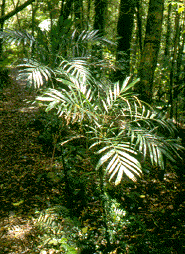 The park is located about two hours south of Brisbane by
bus. The valleys and peaks of Lamington are home to two types of
rainforest: the warm tropical rainforest common in coastal areas of
Queensland and remnants of the cooler subtropical rainforest that
blanketed Australia when it was still part of Gondwana some 50 million
years ago.
The park is located about two hours south of Brisbane by
bus. The valleys and peaks of Lamington are home to two types of
rainforest: the warm tropical rainforest common in coastal areas of
Queensland and remnants of the cooler subtropical rainforest that
blanketed Australia when it was still part of Gondwana some 50 million
years ago.
There are two sections (entrances) to Lamington National Park: the Green Mountains section which we visited the Hobart and William Smith program visited in both 1994 and 1996 and the Binna Burra section. There are over 150 km of well-maintained trails throughout the park making it is possible to hike between the two sections.
A Walking Stick Palm along the main Border Walk track on the 15 km hike
out to see the ancient Antarctic Beech Forest.
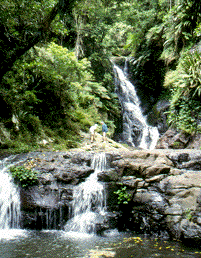 Lamington forms part of a huge shield volcano that originally was centered at
Mt Warning in northern New South Wales. Erosion of the softer volcanic rocks has
resulted in a rugged terrain with a high plateau cut by many gorges and waterfalls.
Lamington forms part of a huge shield volcano that originally was centered at
Mt Warning in northern New South Wales. Erosion of the softer volcanic rocks has
resulted in a rugged terrain with a high plateau cut by many gorges and waterfalls.
Elebana Falls is one of the many waterfalls along the return
trail from Bithongabel at Lamington.
In drier sections of the park, near the overlook at Pat's Bluff for example, the forest canopy opens up permitting differently adapted plants to flourish, among them grass trees.
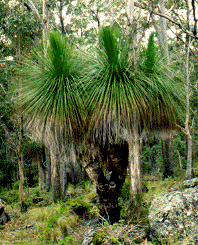
Family: Xanthorrhoeaceae Species: Xanthorrhoea johnsonii "Grass Trees"
Grass trees were encountered at Lamington,
Stradbroke Island, and Carnarvon Gorge.
Some species are not only
resistant to fire but are actually stimulated to flower by it.
According to information from the
Australian
National Botanic Gardens, the Aboriginal
peoples of Australia used grass trees as a food source.
"The bases of the leaves are sweet and nutty, and the heart of the stem was also eaten. Nectar was
collected from the tall spike of flowers with a sponge made of stringybark. The dry flower-stems
of smaller species were used for spears, and those of this larger species were used to make fire, as
well as containing large edible grubs. At the base of the plant globules of a hard waterproof resin
were collected, which served as a cement to fasten barbs in spears or stone axes to handles. The
tough leaves were used as knives to cut meat."
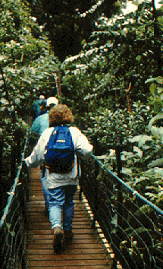 The rope and wood slat bridge through the canopy of the forest is a unique
attraction of the park.
(Julie Zelazny '96 on the canopy walk approximately 10--15m above the forest
floor. A tower at one section of the walk rose 30m above ground and provided
a different perspective on the forest for those willing to climb it. (Photo 1994)
The rope and wood slat bridge through the canopy of the forest is a unique
attraction of the park.
(Julie Zelazny '96 on the canopy walk approximately 10--15m above the forest
floor. A tower at one section of the walk rose 30m above ground and provided
a different perspective on the forest for those willing to climb it. (Photo 1994)
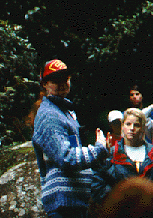 During the first and second days at Lamington, Anita Smythe and Chris Pavey of
from the University of Queensland provided background lectures
on the life histories of some of the animals in the park and the methods used to
study these animals. They also led bird walks and nighttime mammal spottings.
During the first and second days at Lamington, Anita Smythe and Chris Pavey of
from the University of Queensland provided background lectures
on the life histories of some of the animals in the park and the methods used to
study these animals. They also led bird walks and nighttime mammal spottings.The park is home to a number of interesting and exotic birds such as king parrots, crimson rosellas, regent and satin bower birds, lyre birds, honeyeaters, logrunners, scrub turkeys, Eastern yellow robins, tawny frogmouths, and so on. Small mammals include pademelons, wallabies, ring-tail and brush-tail possums, and sugar gliders. Reptiles include carpet pythons, red-bellied black snakes, and mountain dragons.
Anita Smythe, an ornithologist from the University of Queensland, is shown here
leading a group of students in a morning bird walk at Lamington (Photo 1994).
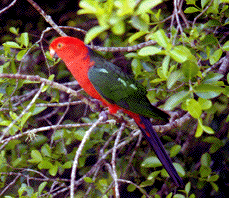
Phylum: Chordata Class: Aves Family: Polytelitidae Species: Alisterus scapularis "King Parrot"
Length 41--44 cm. A large long-tailed parrot with red belly. The male has a bright
red head and breast and a back of bright green. They often travel
in small flocks and feed mainly on dry seed on the ground. They are fairly
common in rainforest and wet schlerophyl and eucalypt forests in eastern Australia.
The female king parrot
has a dull green head and back with a brownish breast.
The king parrot is common near
the O'Reilly's Guest House at Lamington.
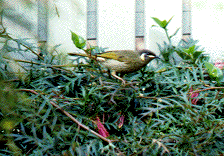
Phylum: Chordata Class: Aves Family: Meliphagidae Species: Meliphagi lewinii "Lewin's Honeyeater"
Length 19--21 cm. There are many species of honeyeaters. This species
is common in dense vegetation and its range includes a band along the eastern
part of Australia. The shrub is Grevillea pteridifolia

Phylum: Chordata Class: Aves Family: Platycercidae Species: Platycercus elgans "Crimson Rosella"
Length 32--36 cm. Rosellas are colorful broad-tailed parrots with distinctive
cheek patches. The crimson rosella has blue cheek patches. There are
two primary forms of the "blue-cheeked rosella" which interbreed:
the one pictured here
which occurs in primarily along the south-east coast, and a yellow rosella
whose range includes areas in South Australia.
Fed by visitors, crimson rosellas are common near
the O'Reilly's Guest House at Lamington.
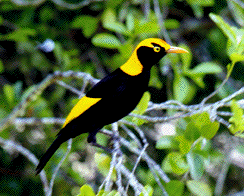
Phylum: Chordata Class: Aves Family: Paradisaeidae Species: Sericulus chrysocephalus "Regent Bowerbird"Length 24--28 cm. The male is a gold and black while the female has a black cap and a brown and gray scalloped back. The male's bower often consists of only a few twigs place along an "avenue." Its range is restricted to rainforests along the middle part of the east coast.
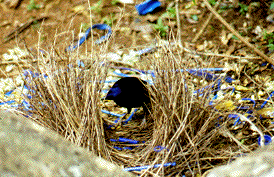
Phylum: Chordata Class: Aves Family: Paradisaeidae Species: Ptilinorhynchus violaceus "Satin Bowerbird"
Length 28--32 cm. The male is a glossy blue-black with violet eye and
the female is a dull blue gray green. Bowers are built by the male as focal
points of territories where courting and mating occur. They are generally
decorated with blue items and flowers (blue or yellow).
Phylum: Chordata Class: Aves Family: Cracticidae Species: Strepera graculina "Pied Currawong"
Length 41--51 cm. The pied currawong is a common nomad or altitudinal migrant
in forests and woodlands.
Class: Mammalia Subclass: Theria Infraclass: Methatheria Species: Thylogale thetis "Red-necked Pademelon"The red-necked pademelon is a somewhat larger diprotodont with a body length of 500mm, tail length of 400mm, and a weight of 6kg. They are common in restricted habitats of rainforest and vine thickets. They are nocturnal and because they graze on grass they are encountered more frequently than most other pademelons.
Class: Reptilia Order: Squamata Species: Morelia spilota variegatta "Carpet Python"Length 2.5 to over 3 m. The range of the carpet python includes rainforest, wet and dry eucalypt forest, pasture lands, and urban areas. In Brisbane it is apparently a frequent resident in house roofs! Its bite is nonvenomous. It feeds on warm-blooded prey such as possums, rats and birds. This one had obviously eaten something recently.
Class: Reptilia Order: Squamata Species: Hypsilurus spinipes "Southern Angle-headed Dragon" or "Mountain Dragon"Body length 13 cm, tail length 40 cm. Dragons have rough skin, long limbs and alert upright postures. They are swift and very keen-eyed, feeding mostly on arthropods.
Phylum: Arthropoda Subphylum: Crustacea Class: Malacostraca Species: Euastacus sulcatus "Lamington Blue Spiny Crayfish"The Lamington Blue Spiny Crayfish can be seen in rock pools and at the base of waterfalls and on walking trails in the summer. Reportedly, when confronted by hikers the crayfish rears up and hisses while moving backwards.
All natural ecosystems are constantly changing. Some of these changes are induced by natural events (e.g. storms, fires, droughts, floods) but increasingly, the changes are caused by human action. Sites at Lamington National Park provide us with ways to examine the nature of various kinds of disturbance, and the ways in which subtropical rainforest responds to such disturbance, the physical and physiological mechanisms behind the processes of recovery, and the influence of disturbance on biological diversity.
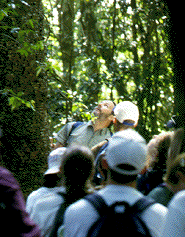 The disturbances experienced at the study area in and around
Lamington National Park include:
The disturbances experienced at the study area in and around
Lamington National Park include:
These disturbances differ in intensity, frequency and duration. Further, different recovery times have elapsed since each occurred. In this way, the area offers the opportunity to examine the ways in which the forest community has responded.
David Yates stops to examine and discuss a forest gap along one of the main hiking
trails.
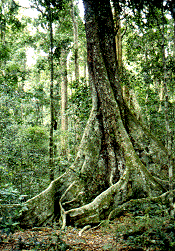 The projects undertaken during the course of this study included:
The projects undertaken during the course of this study included:
A common feature of many of the large trees in the rainforest are
the huge buttresses used for additional support in the
thin soils in the rainforest.
Regrowth Following Clearing for Agriculture: Two sites were be used. Site 1 was an area cleared for pasture but abandoned in 1964 while site 2 was forest cleared and burned in 1922. The area was seeded with pasture species but weeds invaded and the pasture abandoned in 1926.
At each of these sites plots (100m x 10m) laid out and various data were collected.
These included:
Steve Smith '98 gathers data for basal area measurements at a site
cleared for pasture but abandoned in 1964.
Tree-fall Gap:
Mature forests have been described as shifting
mosaics of different sized patches cycling through gap,
building and mature phases. It has been suggested that
disturbance is necessary for the maintenance of species
diversity in the rainforest flora. The first natural disturbance
we will examine is the tree-fall gap. Gaps are seen as essential
components of tropical forest functioning, maintaining
species diversity, and providing a range of niches for
plant establishment.
Storm Damage: A severe storm passed through the Lamington National Park region in 1983. Severe damage was confined mostly to a narrow strip up to several hundred meters wide along the path of the storm. Less severe damage occurred over much larger areas. In one sense the storm simply caused massive damage to the standing forest. But in another, it created a series of gaps in the canopy of quite different sizes. These differences will affect the regeneration processes in these areas for some time to come.
K. Morrell '99, M. Dickson '97, and G. Krull '98
collect point-centered quarter data.
Past Disturbances:
Lophostemon confertus (Brush Box) are often found in moist gullies
and on rainforest margins. They are partially shade tolerant but
will not normally regenerate within rainforests. A Brush Box stand
is therefore likely to be indicative of a significant past disturbance.
We visited one such stand made up of a number of very large trees (900 to 1000 years old) and discussed the possible ecological circumstances that produced it.
L. Lamme, K. Hammontree, T. Whitwood, C. Perkowski, and M. Dickson
at the base of an ancient Brush Box tree shortly after a storm.
The week's activities also included time for an
18 km hike to an Antarctic beech (Nothofagus moorei) forest.
Lectures in Brisbane highlighted Australia's distant Gondwanan origins and
its more recent geographic isolation and what this has meant for the
evolution of plants and animals on the continent. These
trees now only occur here and in isolated spots in South America,
but are contained in the Antarctic fossil record. This points to a
time when all four continents were connected near the south pole and
global temperatures were much warmer.
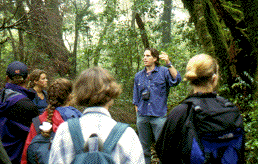 Accompanying lecture/discussions led by Don Butler and David Yates highlighted
the temperature and light stresses in the rainforest canopy and the
differences between the canopy and forest floor
Accompanying lecture/discussions led by Don Butler and David Yates highlighted
the temperature and light stresses in the rainforest canopy and the
differences between the canopy and forest floor
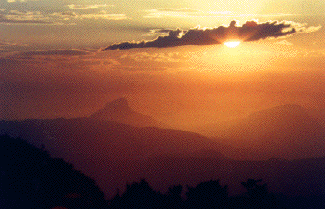 "It is 5:37pm, I'm sitting on the grounds below O'Reilly's Guesthouse.
The sun is slowly descending over the hazy mountains. Just a
few meters away sit grazing red-legged pademelons. A few have
joeys. The king parrots, crimson rosellas, and bowerbirds fill the air by
sound and wing. The clouds glow as the sun's light decreases over the rainforest.
I feel as if I'm in heaven!" Susan Flanders '98
(B. Wood '98 Photo).
"It is 5:37pm, I'm sitting on the grounds below O'Reilly's Guesthouse.
The sun is slowly descending over the hazy mountains. Just a
few meters away sit grazing red-legged pademelons. A few have
joeys. The king parrots, crimson rosellas, and bowerbirds fill the air by
sound and wing. The clouds glow as the sun's light decreases over the rainforest.
I feel as if I'm in heaven!" Susan Flanders '98
(B. Wood '98 Photo).
This Lamington National Park website developed by the Univesity of Queensland features a links to the wildlife and geology of the park.